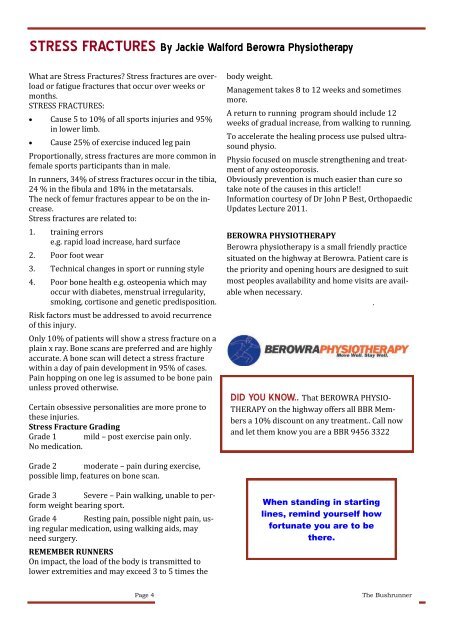The Bushrunner - Berowra Bush Runners
The Bushrunner - Berowra Bush Runners
The Bushrunner - Berowra Bush Runners
You also want an ePaper? Increase the reach of your titles
YUMPU automatically turns print PDFs into web optimized ePapers that Google loves.
STRESS FRACTURES By Jackie Walford <strong>Berowra</strong> Physiotherapy<br />
What are Stress Fractures? Stress fractures are overload<br />
or fatigue fractures that occur over weeks or<br />
months.<br />
STRESS FRACTURES:<br />
� Cause 5 to 10% of all sports injuries and 95%<br />
in lower limb.<br />
� Cause 25% of exercise induced leg pain<br />
Proportionally, stress fractures are more common in<br />
female sports participants than in male.<br />
In runners, 34% of stress fractures occur in the tibia,<br />
24 % in the fibula and 18% in the metatarsals.<br />
<strong>The</strong> neck of femur fractures appear to be on the increase.<br />
Stress fractures are related to:<br />
1. training errors<br />
e.g. rapid load increase, hard surface<br />
2. Poor foot wear<br />
3. Technical changes in sport or running style<br />
4. Poor bone health e.g. osteopenia which may<br />
occur with diabetes, menstrual irregularity,<br />
smoking, cortisone and genetic predisposition.<br />
Risk factors must be addressed to avoid recurrence<br />
of this injury.<br />
Only 10% of patients will show a stress fracture on a<br />
plain x ray. Bone scans are preferred and are highly<br />
accurate. A bone scan will detect a stress fracture<br />
within a day of pain development in 95% of cases.<br />
Pain hopping on one leg is assumed to be bone pain<br />
unless proved otherwise.<br />
Certain obsessive personalities are more prone to<br />
these injuries.<br />
Stress Fracture Grading<br />
Grade 1 mild – post exercise pain only.<br />
No medication.<br />
Grade 2 moderate – pain during exercise,<br />
possible limp, features on bone scan.<br />
Grade 3 Severe – Pain walking, unable to perform<br />
weight bearing sport.<br />
Grade 4 Resting pain, possible night pain, using<br />
regular medication, using walking aids, may<br />
need surgery.<br />
REMEMBER RUNNERS<br />
On impact, the load of the body is transmitted to<br />
lower extremities and may exceed 3 to 5 times the<br />
Page 4<br />
body weight.<br />
Management takes 8 to 12 weeks and sometimes<br />
more.<br />
A return to running program should include 12<br />
weeks of gradual increase, from walking to running.<br />
To accelerate the healing process use pulsed ultrasound<br />
physio.<br />
Physio focused on muscle strengthening and treatment<br />
of any osteoporosis.<br />
Obviously prevention is much easier than cure so<br />
take note of the causes in this article!!<br />
Information courtesy of Dr John P Best, Orthopaedic<br />
Updates Lecture 2011.<br />
BEROWRA PHYSIOTHERAPY<br />
<strong>Berowra</strong> physiotherapy is a small friendly practice<br />
situated on the highway at <strong>Berowra</strong>. Patient care is<br />
the priority and opening hours are designed to suit<br />
most peoples availability and home visits are available<br />
when necessary.<br />
.<br />
DID YOU KNOW.. That BEROWRA PHYSIO-<br />
THERAPY on the highway offers all BBR Members<br />
a 10% discount on any treatment.. Call now<br />
and let them know you are a BBR 9456 3322<br />
When standing in starting<br />
lines, remind yourself how<br />
fortunate you are to be<br />
there.<br />
<strong>The</strong> <strong><strong>Bush</strong>runner</strong>


